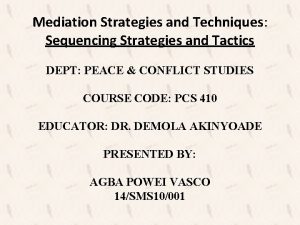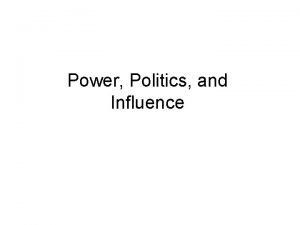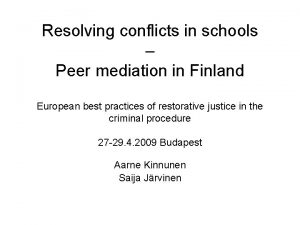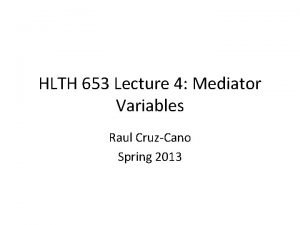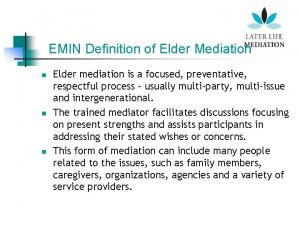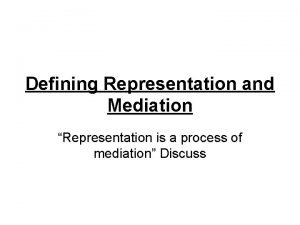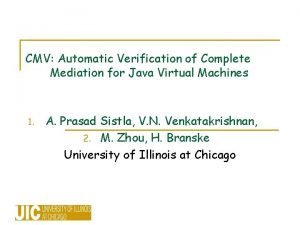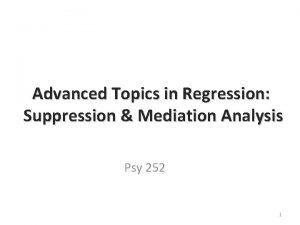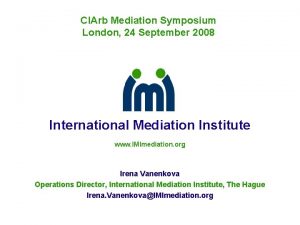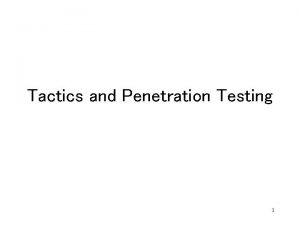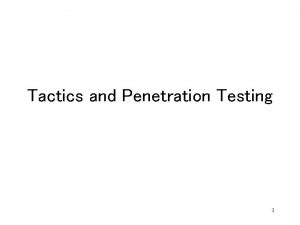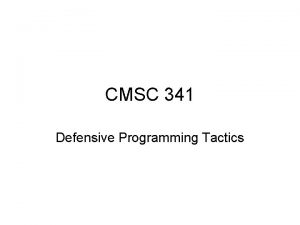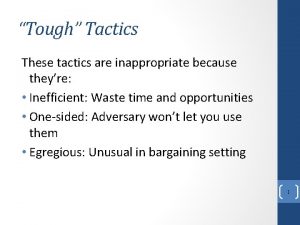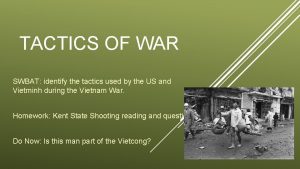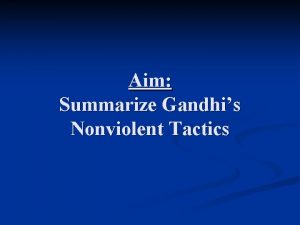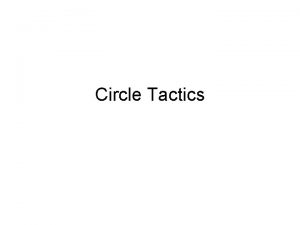Mediation Strategies and Techniques Sequencing Strategies and Tactics

























- Slides: 25

Mediation Strategies and Techniques: Sequencing Strategies and Tactics DEPT: PEACE & CONFLICT STUDIES COURSE CODE: PCS 410 EDUCATOR: DR. DEMOLA AKINYOADE PRESENTED BY: AGBA POWEI VASCO 14/SMS 10/001

Table of content • Brief introduction on sequencing strategies and tactics • What is sequencing strategies and tactics • General sequencing models • Tactics related to sequencing • Consequences • Conclusion • Reference

Brief introduction on sequencing strategies and tactics Negotiators and mediators who deal with very large social conflicts have to skillfully manage a very complex and diverse set of challenges. In order to do that, these people must think about the best way to order or sequence the issues in a particular conflict. There a number of models that enable a negotiator or mediator to make sense out of the complexity and design the best process in order to try to address the issues in the conflict.

What is sequencing strategies and tactics Sequencing Strategies is defined as the overall plan for how to approach an issue, while tactics are singular actions taken in order to achieve the desired ends of a strategy.

General Sequencing Models There are many variations, the following models tend to be the manner in which negotiators and mediators approach large social conflicts: (1) Gradualism (also called Incrementalism, or see Negotiation Strategies) (2) Boulder in the Road (3) Committee (4) Formulaic (also called Agreement-in-Principle) (1) Gradualism (also called Incrementalism, or see Negotiation Strategies): The mediator attempts to move the parties from simpler to more complex issues (as defined by the parties). It was propounded by U. S. Secretary of State Henry Kissinger's efforts in the Middle East as well as the more recent Oslo Process between the Israelis and Palestinians. The reason behind the approach is that trust is low and so the parties need to take small steps to create initial trust and/or foster a positive atmosphere such that subsequent vital issues may be broached. Pros It is the most logical and the most practical of all the sequencing strategies. It is flexible. . . it can be changed as needed. Cons It is susceptible to manipulation by the parties, particularly by the more powerful party, as it can control the process more easily. It is vulnerable to spoilers whose intent is to disrupt the process. It requires patience and ignores the fact that the populaces want tangible change quickly.

General Sequencing Models continue (2) Boulder in the Road: It is the opposite of the gradualism approach. It proposes to address the more complex issues first, thereby moving the "boulder" or greatest obstacle, which enables an easier resolution of the remaining issues. This approach might, in some ways, seem to be counterintuitive because the core issues have confounded and hence blocked settlement for years and even decades. However the stage of the conflict and whether the conflict is ripe for resolution due to either a mutually hurting stalemate. Pros It is a high-reward strategy. It is a bold strategy that seriously challenges the intentions of the conflict parties from the outset. It prevents parties from manipulation of small agreements in a manner that suggests a lack of good faith. It attempts to bind the parties to the peace process and thus quickly determines the sincerity of the involved parties. Cons It is a high-risk strategy. If there is a breakdown in the negotiation process, the outcome is most likely renewed violence or even overt war. Negotiators/Mediators may simply not consider this approach because it appears unrealistic, particularly if they receive initial negative feedback from the discordant parties.

General Sequencing Models continue (3) Committee: Instead of employing either an easy-to-hard or hard-to-easy sequence, negotiators/mediators take the hard issues that the different parties highlight and divide the parties into committees to deal with each issue. These committees work simultaneously on specific issues in smaller groups, and then their resolutions are presented to the larger group. All the committees tend to work under the mantra that nothing is agreed until everything is agreed. Pros The parties are essentially forced into a cooperative attitude on issues previously considered non-negotiable. Its ability to separate complicated issues, addressing them in an isolated manner -- so other smaller issues cannot muddy the process of resolving the more contentious issues. It follows the mantra of "nothing is agreed until everything is agreed" and is therefore independent yet flexible. Cons The negotiators are not part of the different smaller committee discussions and, as a result, they lack an understanding of how specific agreements were arrived at and decided upon. Coordination between the different subset committees is challenging. There is less opportunity to link or package issues to resolve a problem because the parties are isolating core issues.

General Sequencing Models continue (4) Formulaic (also called Agreement-in-Principle): This approach involves reaching a general agreement early in the process with the intention of working out the details at a later stage. This general agreement is purposely vague in order to keep the parties at the table, set a positive tone for the rest of the process, and build momentum. Pros It is general enough that the parties are likely to reach an initial agreement without having to commit to too much concretely. It generally sets a positive tone of working together and shows the parties they can cooperate. It provides enough vagaries for interpretation by different parties and leaders. Cons It often gets stuck in the general agreement stage -- the devil is in the details. It is vague and open to interpretation, so parties may think they have agreed when they really have not, or they run into interpretation problems. It may raise hopes prematurely that an agreement will be easier than previously thought.

Tactics Related to Sequencing The followings are some of the more commonly used tactics namely (1) Fractionation (or Fractionalization) (2) Holisticism (3) Irrevocable Commitments (4) Linking (5) Nothing is Agreed until Everything is Agreed (6) Packaging (7) Salami Slicing Note: the different strategies are tactics or specific actions negotiators or mediators may take to advance their overall strategy. A specific tactic is by no means bound to a particular strategy, certain tactics tend to be employed when a certain strategy is used. For example, fractionation (breaking big issues down into smaller pieces or "fractions") is most closely associated with the gradualism strategy. (1) Fractionation (or Fractionalization): The process of dividing the most difficult issues into smaller parts in order to keep a situation from escalating and thereby making the issues more manageable. As mediator Bernard Mayer explains, "The art of fractionalization is to divide a conflict into manageable chunks that are neither too small nor too large and that do not isolate any major issue in a way that makes creative problem-solving more difficult. "

Tactics Related to Sequencing continue Holisticism: The process of addressing issues in their entirety without breaking them into smaller elements. This is done particularly with issues that do not lend themselves to being broken down easily. Irrevocable Commitments: The process of making a concession that is virtually impossible to rescind. This is used to try to positively entrap the parties in the process, making it very difficult for them to leave the table. Linking: The process of conjoining one issue with another for the purposes of settling both issues. Nothing is Agreed until Everything is Agreed: A philosophical approach that highlights for the parties they should feel free to generate all sorts of ideas, and not be bound by any one of them until all the issues in question are agreed to. Packaging: The process of negotiating and linking multiple issues together for the purposes of reaching a comprehensive agreement. Salami Slicing: The process of taking the whole conflict or a single issue in the conflict, viewing it as a "salami, " and slicing off pieces until one has dealt with the entire problem. Focusing on the easier elements of a specific problem first is generally how this is accomplished.

Conclusion A good mediator uses many strategies and tactics to help the parties reach agreement. Sequencing Strategies and Tactics is when Mediators dealing with very large social conflicts have to skilfully manage a very complex and diverse set of challenges. In order to do that, these people must think about the best way to order or sequence the issues involved in their conflict.

Reference • Pcs 410 class note • file: ///C: /Users/User/Downloads/The%20 Third%20 Side%20%20 Str ategies%20 and%20 Tactics%20 of%20 Mediation%20%20%20 Beyon d%20 Intractability. htm

Thank you 4 listening


MEDIATION STRATEGIES AND TECHNIQUES: REALITY TESTING DEPT: PEACE & CONFLICT STUDIES COURSE CODE: PCS 410 EDUCATOR: DR. DEMOLA AKINYOADE PRESENTED BY: AGBA POWEI VASCO 14/SMS 10/001

Table of content • • Brief introduction on reality testing What is reality testing How is reality testing is done Vital questions in the process of Reality testing Consequences Example Conclusion Reference

Brief introduction on reality testing Reality testing is one of the over thirteen (13) strategies and techniques of mediation in the universe that help parties in conflict situation reach agreement and resolve their differences peacefully.

Reality Testing What is Reality Testing? Is one of the strategies and techniques of mediation that used when negotiation has breakdown that assist the parties to a particular conflict to see mediation as the only means of resolving the conflict amicably. Fisher, Ury, and Patton called this a better BATNA). If a party thinks they have a good BATNA, then they may refuse to agree to a settlement, causing an obstacle in the negotiation process. However, a party's BATNA is often unrealistic. If a party is refusing to agree to a settlement based on an unrealistic BATNA, then the mediator or opposing party must educate the reluctant party through reality testing.

How is Reality Testing Done? The genuine process of reality testing involves asking hard questions about each parties power and options. Either the mediator or the opposing party must convince the resistant party that their BATNA is not as good as it seems and get them to understand what will happen if they stick with it. There are many reality-testing questions one may ask.

Vital questions in the process of Reality testing There are eight (8) remarkable questions we need to ask during the process of real testing basically; (1) What do you see as the strengths of your case? (2) What do you see as the weaknesses of your case? (3) What do you see as the strengths of the other's case? (4) What do you see as the weaknesses of the other's case? (5) What is your best-case scenario if you don't resolve this with negotiation? (6) What is your worst-case scenario if you don't resolve this with negotiation? (7) What is the most likely scenario if you don't resolve this with negotiation? (8) Is that better than the most likely negotiated settlement?

Consequences If an opponent has not really thought through the consequences of disagreement, you could ask: Do you realize how serious the consequences will be for both of us if we don't settle this issue? Third parties can be especially helpful in this regard. They can act like counselor. By getting the party to do a better job of costing, the third party can sometimes get the reluctant party to agree to mediation, or a particular settlement. If a party is unwilling to try mediation, preferring litigation instead, the mediator or lawyer might ask, who do you think will win? What are the strengths of your case? How much will a lawsuit cost? How long will it take? What will happen in the meantime?

Example In trying to reach an agreement in Northern Ireland, mediator George Mitchell told the parties that if they did not reach an agreement, thousands more people would likely die. “And history will hold you accountable, " he told the negotiators. "Do you want to be responsible for that? " Mitchell reported when asked what the turning point in the negotiations that it was this question, along with an artificial deadline imposed by Mitchell, that pushed them on towards agreement.

Conclusion Reality Testing is sometimes parties believe that they have an alternative or option that is better than what they will get through participating in mediation. Reality testing involves asking questions about each party's options and convincing resistant parties that mediation is their best option. A good mediator uses many strategies and tactics to help the parties reach agreement and reality testing is one of this mechanisms.

Reference • Pcs 410 class note • file: ///C: /Users/User/Downloads/The%20 Third%20 Side%20%20 Str ategies%20 and%20 Tactics%20 of%20 Mediation%20%20%20 Beyon d%20 Intractability. htm

Thank you 4 listening
 Sequencing strategies and tactics
Sequencing strategies and tactics A key part of backstabbing as a political tactic is to
A key part of backstabbing as a political tactic is to Volleyball hitting chart
Volleyball hitting chart Public relations strategies and tactics
Public relations strategies and tactics Nyit blackboard
Nyit blackboard Peer mediation definition
Peer mediation definition Bscs billing system
Bscs billing system Andy field moderation
Andy field moderation Billing mediation system
Billing mediation system David kenny mediation
David kenny mediation Moderator vs mediator
Moderator vs mediator Mediation vs moderation
Mediation vs moderation Mediation examples
Mediation examples Mediation definition
Mediation definition Representational mediation process
Representational mediation process Incomplete mediation in information security
Incomplete mediation in information security Complete mediation example
Complete mediation example What is incomplete mediation
What is incomplete mediation Chapter 7 conflict resolution answer key
Chapter 7 conflict resolution answer key Incomplete mediation in information security
Incomplete mediation in information security Mediation hypothesis example
Mediation hypothesis example Mediation device protocol in wsn
Mediation device protocol in wsn Incomplete mediation in information security
Incomplete mediation in information security Mediation nz
Mediation nz Family mediation brussels
Family mediation brussels Ciarb mediation symposium
Ciarb mediation symposium
